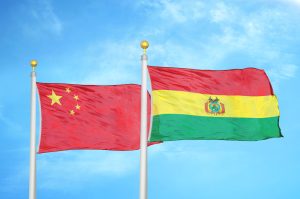Bolivia is facing one of the worst economic and financial crises in its history. GDP growth is at its lowest level in two decades, with an economic recession, payments crisis, high inflation, and high unemployment rates to boot. The Bolivian Central Bank is also running out of foreign currency, particularly U.S. dollars, which much of the Bolivian middle class relies on for financial stability and market predictability. Recent scandals in Bolivia’s energy production, including long-term shortages of natural gas and electricity in remote areas, add to the turmoil.
With the United States deprioritizing Bolivia, given its souring relations with the socialist-led government in La Paz, China has been mobilizing quickly to come to Bolivia’s aid and increase its clout in the region. China has provided assistance for Bolivia to get through other crises in the recent past, including the COVID-19 pandemic, where Beijing gifted millions of vaccine doses to the country’s population. While China’s financial support and strategic investments will bail Bolivia out of its worst economic crisis, China stands to gain the most from the partnership as it will shift the South American country’s economic dependence away from the United States.
As Bolivia’s $15 billion in international reserves has dwindled to $2 billion, China has provided Bolivia with increasing sums of yuan. Bolivia is now able to use Chinese currency for trade settlement purposes, allowing it to de-dollarize its trade and escape the worst effects of its economic crisis. About 10 percent of Bolivia’s trade is now in yuan. Bolivia is following in the path of Argentina and Brazil, which have been de-dollarizing as a way to reduce dependency on U.S.-led markets and diversify their economic and financial profile.
Through the Forum of China and the Community of Latin American and Caribbean States (China-CELAC Forum), Bolivia has become a growing partner to China in a region previously dominated by the United States. With this year marking the 10th anniversary of the China-CELAC Forum, talks between Beijing and La Paz have been more significant and more frequent. In late April, Bolivia’s Minister of Foreign Affairs Celinda Sosa Lunda visited China to discuss growing their trade and economic partnership.
At the meeting in Beijing in, Sosa Lunda and Chinese Foreign Minister Wang Yi discussed the possibility of Bolivia’s entry into the BRICS bloc of nations. They reinforced their stand against U.S. “hegemony and bullying,” while tentatively discussing infrastructure investment under the Belt and Road Initiative. U.S. assistance and trade with Bolivia, meanwhile, has been on a steady decline since the early 2000s. China has now overtaken the U.S. as Bolivia’s main trading partner, at a rate of about five-to-one.
In the face of economic and financial disaster, China has also provided Bolivia with greater loans and investments. In the last year, China signed a deal for $1.4 billion (previously $1 billion) to have a consortium of three Chinese state-owned companies extract Bolivian lithium through a variety of industrial plants. The country boasts the world’s single largest reserves of lithium. A $350 million (previously $250 million) loan from the Export-Import Bank of China, repayable over 20 years at an interest rate of 2 percent, also allowed Bolivia to build a zinc refining plant, with zinc being one of Bolivia’s main exports. Despite slowing production and logistical problems with energy exports, these programs from China have helped Bolivia face its economic slump.
With these currency loans and investment loans, China is now Bolivia’s main source of foreign credit, though it still represents a small part of its overall external debt. Bolivia’s yuan reserves are also growing, both nominally and as a share of its total foreign currency reserves. The yuan is now the fastest-growing currency in the Bolivian Central Bank foreign reserves. Bolivian consumers and business owners are also choosing the yuan over the dollar to conduct business and trade. President Luis Arce’s government, like other South American governments, is seeing this as an “alternative option” to the “crisis of dollar liquidity.”
This timely support from China will likely push Bolivia further into an alternative regional order, where South American states led by left-leaning governments are relying on China instead of the U.S. for assistance and partnership. Arce reinforced this idea himself in an interview with CGTN America, a Chinese state-controlled outlet, stating that “China comes from a popular government … that cares about people” and that Bolivia is part of a group of “many countries that are trying to make a different world, a more equal world, and more justice in the world.”
China is strengthening its posture among non-Western countries, attempting to build its branding as a representative for the Global South. While the U.S. is seen as a difficult ally, China is perceived as a more neutral, stable partner. As a result, a growing number of Bolivians are now seeing China as a trustworthy bet for the future of their nation – without the U.S. as the sole dominant force.

































